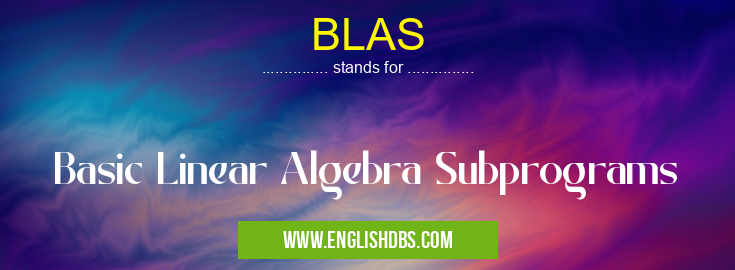What does BLAS mean in SOFTWARE
BLAS (Basic Linear Algebra Subprograms) is a collection of standardized subroutines used in numerical linear algebra. It provides a set of optimized routines for performing common mathematical operations on vectors and matrices. BLAS operations are highly efficient and widely used in scientific computing, engineering, and other fields that require extensive numerical computations.

BLAS meaning in Software in Computing
BLAS mostly used in an acronym Software in Category Computing that means Basic Linear Algebra Subprograms
Shorthand: BLAS,
Full Form: Basic Linear Algebra Subprograms
For more information of "Basic Linear Algebra Subprograms", see the section below.
Definition
BLAS is a library of subprograms that perform basic linear algebra operations on vectors and matrices. It is typically implemented in a low-level language such as Fortran or C, and provides highly optimized routines for specific operations. BLAS operations are designed to be efficient and portable, allowing them to be used on different computer architectures and operating systems.
Key Features
- Standardization: BLAS defines a standard set of operations, ensuring consistency and interoperability across different implementations.
- Optimization: BLAS routines are highly optimized using techniques such as loop unrolling, vectorization, and cache optimization.
- Portability: BLAS implementations are designed to be portable across different platforms, including different operating systems and hardware architectures.
- Widely Used: BLAS is widely used in scientific computing, engineering, and other fields that require heavy numerical computations.
Usage
BLAS subroutines are typically called from within higher-level programs or libraries. They provide a low-level interface for performing common linear algebra operations, such as:
- Matrix-matrix multiplication
- Matrix-vector multiplication
- Vector-vector operations
- Norm calculations
- Triangular system solving
Benefits
- Efficiency: BLAS routines are highly optimized, resulting in significant performance improvements compared to manually coded operations.
- Reliability: BLAS implementations are thoroughly tested and documented, ensuring accurate and reliable results.
- Code Reusability: By using BLAS, developers can avoid writing their own optimized routines, saving time and reducing the risk of errors.
- Performance Portability: BLAS operations can be easily ported across different platforms, ensuring consistent performance across different systems.
Essential Questions and Answers on Basic Linear Algebra Subprograms in "COMPUTING»SOFTWARE"
What is BLAS?
BLAS stands for Basic Linear Algebra Subprograms. It is a collection of standardized low-level routines for performing common linear algebra operations. BLAS provides efficient implementations for operations such as matrix multiplication, vector addition, and matrix inversion.
Why use BLAS?
BLAS offers several benefits:
- Platform independence: BLAS routines are designed to work across different hardware platforms and operating systems.
- Optimized performance: BLAS routines are highly optimized for performance, utilizing hardware-specific optimizations when possible.
- Consistency: BLAS provides a consistent interface for performing linear algebra operations, simplifying code development.
What are the different levels of BLAS?
BLAS is organized into three levels:
- Level 1: Vector operations, such as vector addition and dot products.
- Level 2: Matrix-vector operations, such as matrix-vector multiplication.
- Level 3: Matrix-matrix operations, such as matrix multiplication and matrix inversion.
How can I use BLAS?
BLAS routines are typically accessed through a programming language interface. Common interfaces include:
- C BLAS: C/C++ interface
- Fortran BLAS: Fortran interface
- LAPACK: Higher-level linear algebra library that uses BLAS routines.
What are the advantages of using BLAS in scientific computing?
Using BLAS in scientific computing provides several advantages:
- Improved performance: BLAS routines are highly optimized for efficiency, resulting in faster execution times.
- Reduced code complexity: By using BLAS, programmers can avoid writing custom linear algebra routines, reducing code complexity and potential errors.
- Portability: BLAS routines are portable across different platforms, ensuring that code can be easily migrated to different systems.
Final Words: BLAS is a powerful library that provides highly optimized and standardized routines for performing basic linear algebra operations. Its wide adoption and portability make it an essential tool for scientific computing, engineering, and other fields requiring extensive numerical computations.
